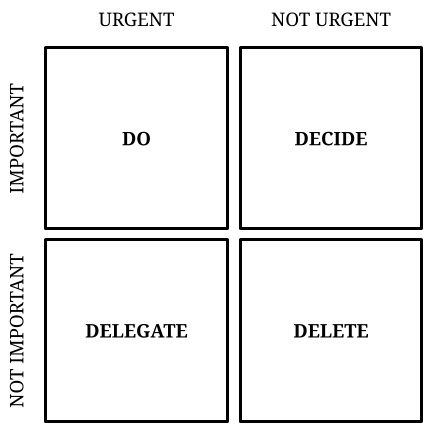Very few decision-making frameworks are as simple and powerful as the Eisenhower matrix. Dwight Eisenhower was the 34th President of the United States and had an incredibly productive life. Amongst many accomplishments, he served as the Supreme Commander of the Allied Forces in Europe during World War II, launched programmes such as DARPA and NASA, and also found the time to serve as President of Columbia University.
How did he do it all?
Eisenhower had a simple but smart productivity system that is often referred to as the Eisenhower matrix. It’s a decision-making method based on the importance and urgency of what’s on your to-do list.
Use the Eisenhower matrix to eliminate time-wasting tasks
Important tasks have an outcome that brings you closer to achieving your goals, whether these are professional or personal. Urgent tasks demand immediate attention because the impending consequences of not dealing with them.
By knowing which tasks are important and which are urgent, you can overcome the illusion of productivity caused by our natural tendency to focus on unimportant and urgent activities. This will help you clear enough time to do what is actually essential to achieve your goals.
First, make a list of everything you want to do. Then, categorise them based on the following criteria.
- Urgent and important
- Important but not urgent
- Urgent but not important
- Neither urgent nor important
The urgent and important tasks, you will do now. The important but not urgent ones can be scheduled to be done later. The urgent but not important activities should be delegated to someone else. Finally, if a task is neither urgent nor important, it should be deleted from your list.

What I love about the Eisenhower matrix is that it forces you to take a step back and ask: “Do I really need to be doing this?” It’s easy to use productivity frameworks to get stuff done without questioning the relevance of the task itself. But, thanks to the Eisenhower matrix, you can build a habit of asking yourself if a particular activity will bring you closer to your goals.
Knowing what is important and time-sensitive is also a great way to beat procrastination. Having a healthy sense of urgency can increase our productivity, without feeling burned out by all the meaningless task we feel need to be done.
You can use the Eisenhower matrix on a daily, weekly or even monthly basis. It works well for micro- and macro-goals. The idea is to have a bird view of what needs to be done, and to get rid of anything that doesn’t align with your long-term goals.
